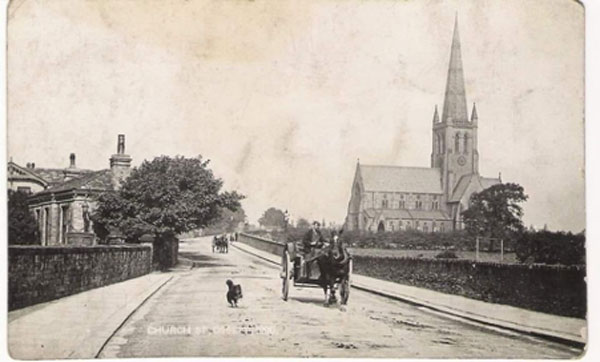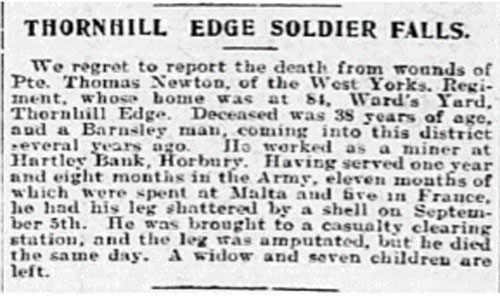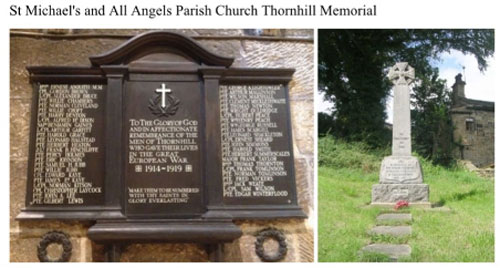
Thomas Newton was born in Leeds in 1878 the sixth child and 5th son of Christopher and Sarah Ann (nee Powlett) who married at St. John’s Church Darlington, Durham County on 22nd December 1867. Christopher Newton was born In Darlington in 1848 and baptised at Barnard Castle, Durham on 25th December 1848. Sarah Ann was born in 1850 in her home town of Oakham in Rutland. By 1871 the couple were living at Buslingthorpe Lane, Leeds with their first two children.
Christopher was a tanner by trade and the family travelled extensively throughout England and Wales. In addition to Thomas the couple had another nine children in six locations in England and Wales between 1868 and 1888. Sadly, Christopher died in 1890, aged 42 years, leaving his wife with ten children between the age of two and 23 years. The 1891 Census records the family, including Thomas, aged 13 years, living on Dewsbury Road Ossett. His widowed mother, Sarah Ann, aged 41 years, was “living on her own means”. Four of her sons were coal miners including Thomas who was 13 years old.
 Church Street Ossett 1900 with Holy Trinity Church (built 1865) on the right
Church Street Ossett 1900 with Holy Trinity Church (built 1865) on the right
On 14th August 1897 Thomas Newton, aged 18, a coal miner of Dewsbury Road, Ossett, married 17 years old spinster Christiana Howden of South Ossett at Holy Trinity Church, Ossett. By 1901 the couple were living at Overton with their first two children, three years old Anice (born late 1897) and Nellie aged 1 year, (born summer 1899). The census recorded the two girls as being born in Ossett; Thomas’s widowed mother was living with them all. By 1911 Thomas and Christiana were living at Alma Street, Wombwell with four of their five surviving children viz Lilly (born 4th October 1901), Violet (30th May 1907), Kathleen (17th October 1910), Louisa (10th April 1913) and Colin (23rd September 1914).The family had with them a 33 years old boarder and friend, Wilson Moody, a builder’s labourer. Wilson Moody had been married to Annie Newton, Thomas’s sister, but she died in 1902. Wilson features later in this biography when, after Thomas Newton’s death in 1916, Wilson married Thomas Newton’s widow, Christiana
War on the German Empire was declared by Great Britain on 4th August 1914 and it is believed that Thomas Newton enlisted with KOYLI at Dewsbury shortly afterwards on 8th/9th December 1914 when he was allotted the KOYLI service number 20582. It is believed that about 6th August 1915, along with a group of KOYLI men, Thomas was transferred to the 1st (Garrison) Battalion West Yorkshire Regiment (WYR) and was allotted a new service number 22598. The 1st (Garrison) Battalion WYR was stationed in Malta throughout the War. These Garrison Battalions were manned by men like Thomas who was seemingly fit enough for rather sedate garrison duties but not for active front-line service. These men could be ex wounded or men who were simply not sufficiently fit/capable enough following enlistment.
Following his service in the Garrison Battalion it appears that Thomas gained sufficient fitness to see him posted to the British Expeditionary Force and 11 months later he was transferred from Malta and joined the 1/5th Battalion West Yorkshire Regiment with service number 5487. His battalion was to be a part of the 146th Brigade of the 49th (West Riding) Division, which had been in France since April 1915 and seen a great deal of activity and lost many of its men since its arrival.
During 1915 the Division saw the Battle of Aubers Ridge (9 May) and the defence against the first Phosgene attack on 19th December 1915. The history of The Great War in 1916 is fairly well known. The year saw the Battle of The Somme come and go between 1st July 1916 and 18th November 1916 as the Division played a major part in the phases of the Battle at Albert (1 July -13 July 1916), Bazentin (14-17 July 16), Pozieres Ridge (23 July – 3 September 1916 and Flers-Courcelette (15-22 September 1916).
September 1916 began relatively quietly with 1/5 battalion in the “Gordon Castle Trenches” clearing enemy fire damage and cutting their wires in defensive lines. The battalion were also preparing for operations for the 3rd September attack on the German lines timed for 5a.m. The attack failed and the enemy heavily shelled during the day; later attacks on the enemy front line in the early evening also failed. At midnight and the following early morning the battalion managed to take back the British front line but the damage was done. On that, and the following day, two officers and 20 “ordinary ranks” were killed; four officers and 73 ordinary ranks were wounded and 10 were missing.
Private Thomas Newton was one of the ordinary ranks wounded during the Battle of The Somme on 3rd September 1916. In spite of a leg amputation he died of those wounds on 5th September 1916. He was 38 years of age and left a widow, Christiana, and five children, 4 daughters and a son, aged between 1 year and 14 years. In these dreadful circumstances there is little else a parent could do in those days other than re-marry and in late 1916 Christiana married her widowed brother-in-law, Wilson Moody, who was living with the family in 1911. The couple lived at 84, Ward’s Yard, Thornhill Edge and in 1921 Christiana and Wilson were living at the same address with four children (Violet, Kathleen, Louisa and Colin) from her marriage with Thomas and two children, Thomas and Averil, from her marriage with Wilson. They had a third child, Mona, in 1924.
After Thomas Newton’s death on the Somme on 5th September 1916¸one (5487) of his two Medal Index Cards (MIC) was a note of a plea from his recently re-married widow, Christiana, who applied for the 1914-15 Star Medal which she believed was due to her late husband. The 1914-15 Star is awarded to service men or women who have served overseas in a theatre of war between 23rd November 1914 and 31 December 1915. Thomas Newton’s service in Malta in 1915 would have qualified him for this Medal except that Malta was not a theatre of war. Whilst his widow may have known he served in Malta for 11 months it is unlikely that she would be aware of the eligibility criterion for an award of the 1914-15 Star which required service overseas in a theatre of war on or before 1916.
 The Dewsbury Reporter 16th September 1916
The Dewsbury Reporter 16th September 1916
Unusually and mistakenly Thomas had two Medal Index Cards (MIC) one with service no. 5487 and a second with 22598. The MIC for 5487 includes the awards of the British and Victory service medals but his widow’s plea for the award of a 1914-15 Star was declined for the above reasons. The MIC 22598 does not include any medal award. The circumstances regarding two Medal Index Cards remains a bit of a mystery but clearer than it might have been thanks to Ossett Fallen’s collaboration with Dewsbury Sacrifices and their contact with The Great War Forum. CWGC and SDGW (UK Soldiers Died in the Great War) commemorate Thomas under his service number 5487. His Soldiers’ Effects Record has him as 22598. The CWGC Graves Registration Documents have him as 22598 but his CWGC headstone refers to his service no. as 5487.
His CWGC Certificate also states his age at death as 41 years when his birth documents suggest it should be 37/38 years. Consideration is being given to an approach to CWGC to clarify Thomas Newton’s age at his death on his CWGC Certificate and the apparent contradiction between the service numbers used by the CWGC Registration and the CWGC Headstone.
Private Thomas Newton 5487 1st/5th battalion West Yorkshire Regiment (Prince of Wales Own) died on 5th September 1916 and is Remembered with Honour at the Doullens Communal Cemetery Extension No.1 at III.E.14. His widow and family had these words on his Headstone for the world to know. HE DIED THAT WE MIGHT LIVE GOD’S WILL BE DONE FROM HIS WIFE & FAMILY UNTIL THE DAY DAWNS.
Photograph courtesy of Richard Houghton & Dewsbury Sacrifice
Thomas is commemorated on the Dewsbury Cenotaph in Crow Nest Park and in the Dewsbury Roll of Honour kept in Dewsbury Central Library. He is also remembered on the Thornhill War Memorial in St. Michael and All Angels Church. Courtesy of Dewsbury Sacrifices.
Thomas will also be remembered at the Ossett War Memorial alongside his brothers and sisters in arms. We know them as The Ossett Fallen.
References
We are grateful for the research undertaken by the Ossett Fallen Team, for the research and photographs shared with us by Dewsbury Sacrifices. http://www.dewsburysacrifices.org/
and for the advice of the Great War Forum.
https://www.greatwarforum.org/
Commonwealth War Graves Commission
https://www.cwgc.org/find-records/find-war-dead/casualty-details/83280/thomas-newton/